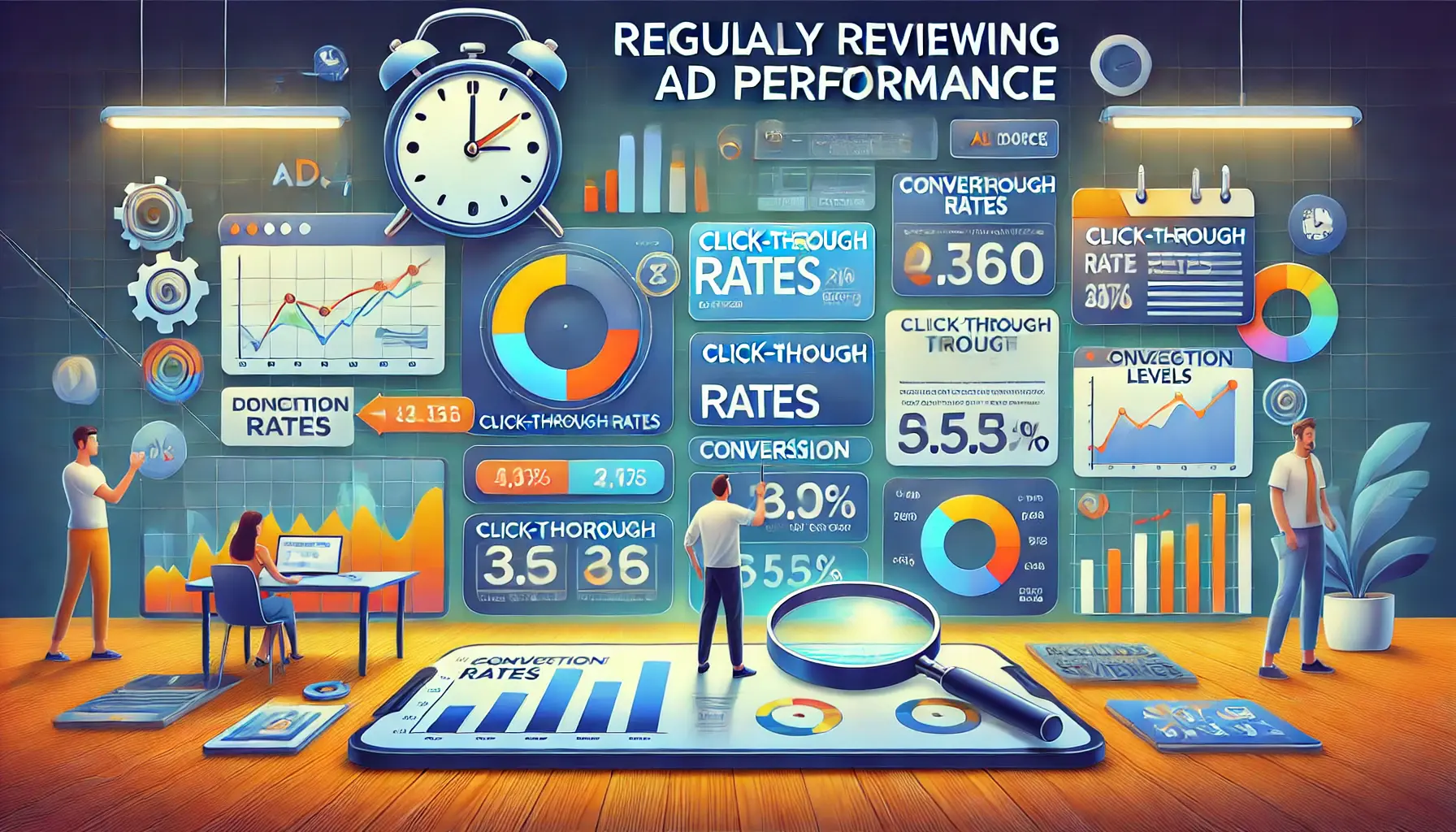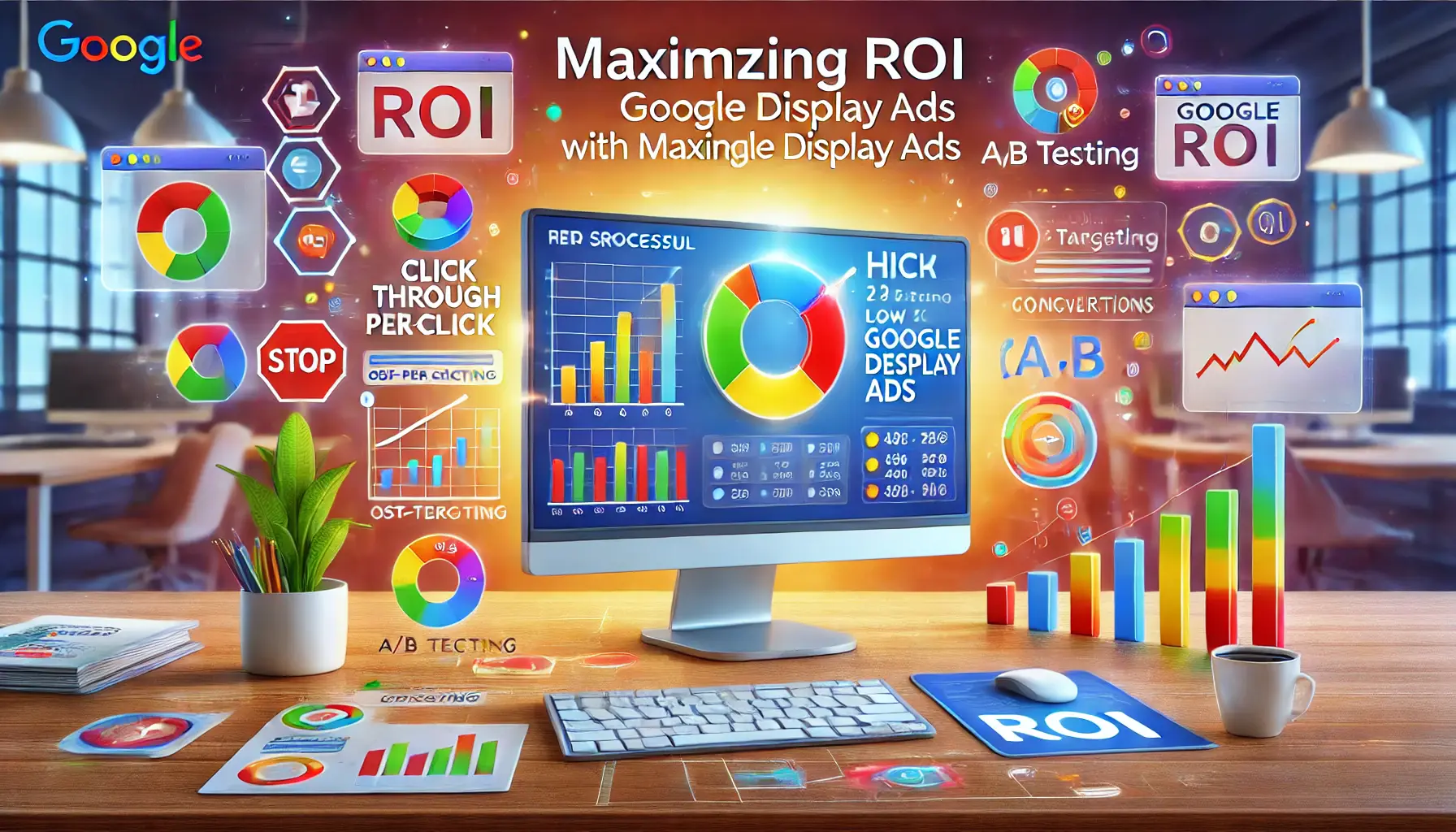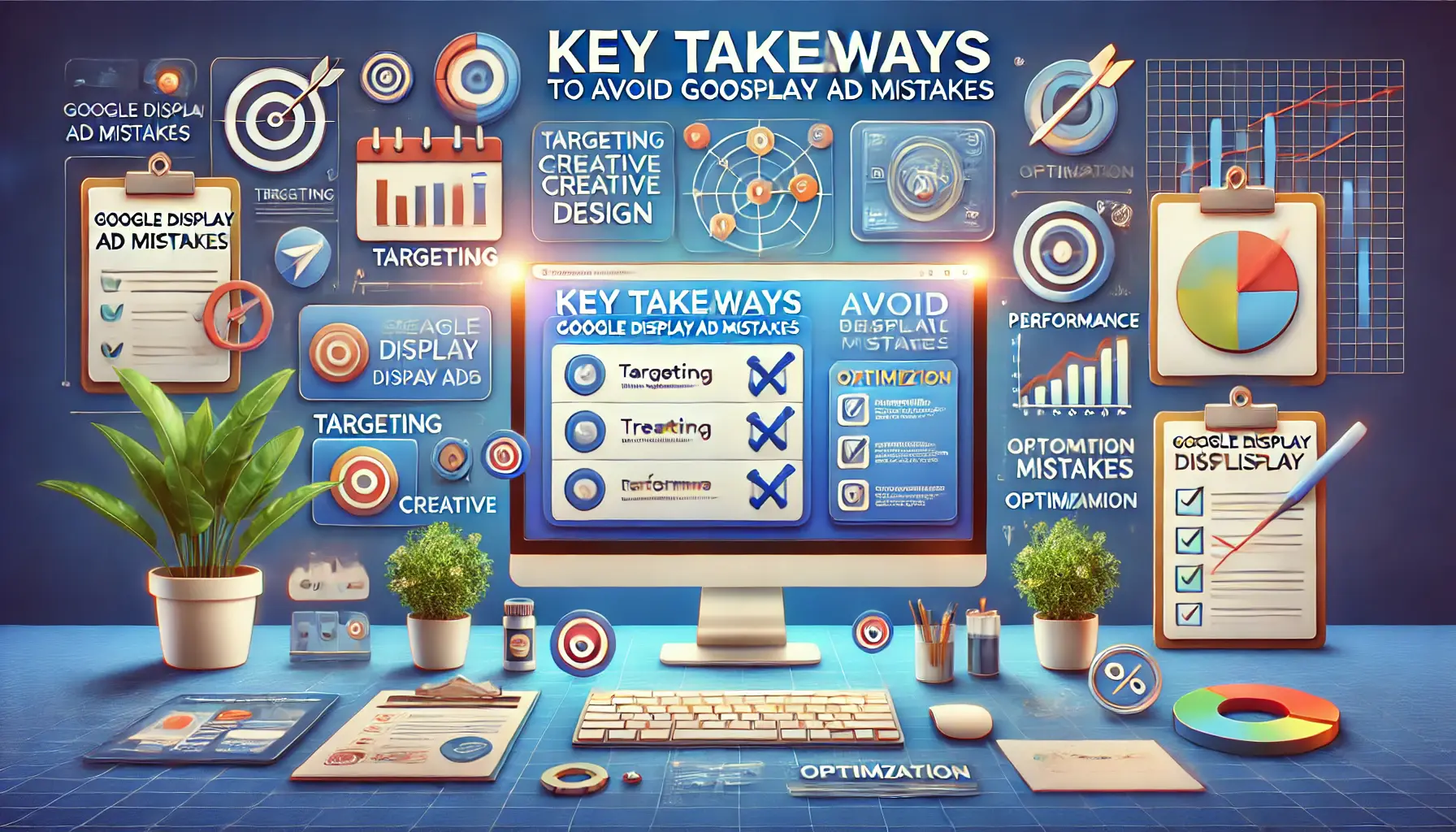With Google Display Ads, the opportunities to reach out to more and more audiences for a business are amazing, but they can also sometimes be a headache to get used to.
The tiniest mistakes made by advertisers running campaigns can result in a complete wastage of budgets, extremely poor click-through rates, and losing out on wonderful opportunities.
Learn from these common ad mistakes so you may improve your campaign and finally reap success from it.
In this article, we’ll go through three crucial ad mistakes in Google Display Ads that you should avoid at all costs to ensure your efforts are fruitful.
Let’s start by talking about one of the most common issues: poor targeting strategies.
Without precise targeting, even the best-designed ads can fail to connect with the right audience, resulting in lower engagement and ROIReturn on Investment; a measure of the profitability of an investment..
- Poor Targeting Strategies That Waste Your Budget
- Neglecting Creative Design and Messaging
- Not Tracking Performance and Making Adjustments
- How to Avoid Mistakes with Google Display Ads
- Maximizing ROI with Google Display Ads
- Key Takeaways to Avoid Google Display Ad Mistakes
- Frequently Asked Questions About Google Display Ad Mistakes
Poor Targeting Strategies That Waste Your Budget
One of the most common ad mistakes in Google Display Ads is failing to create effective targeting strategies.
Poor targeting can cause your ads to appear in front of irrelevant audiences, leading to wasted ad spend and underwhelming campaign performance.
When your ads don’t reach the right people, they won’t generate the clicks, conversions, or engagement you’re aiming for.

Precision targeting with audience insights for effective advertising.
Understanding the Importance of Audience Targeting
Effective audience targeting is the backbone of any successful Google Display Ad campaign.
Google provides a variety of tools to help you define your audience, including demographics, interests, and in-market segments.
If you’re not leveraging these tools properly, you may be casting too wide a net or focusing on an audience that isn’t interested in your offerings.
- Demographics: Ensure you’re targeting people within the right age range, gender, and income level for your product or service.
- Interests: Align your ads with topics or hobbies that your ideal customers are passionate about.
- In-Market Segments: Target users who are actively searching for products or services similar to yours.
By narrowing your focus, you can create campaigns that resonate more effectively with your audience.

Understanding the impact of overlapping audiences on ad campaigns.
How Overlapping Audiences Affect Campaigns
Another mistake advertisers often make is overlapping audience segments.
Though targeting multiple groups at once might sound great, it could also mean a waste of resources due to higher costs and decreased performance.
Overlapping audiences can confuse Google’s algorithms and hinder their ability to identify the most relevant users for your ad.
To avoid this, regularly review your targeting settings and refine your audience segments.
Using tools like the Audience Insights Report can help you identify overlapping groups and fine-tune your campaigns.
Focusing on audience targeting can significantly improve the performance of your Google Display Ads.
By avoiding these mistakes, you’ll maximize your budget and connect with the users who are most likely to engage with your ads.
Refining your audience targeting can dramatically enhance ad performance, saving budget and improving ROI.

The impact of neglecting creative design and messaging in digital advertising.
Neglecting Creative Design and Messaging
A big mistake in running Google Display Ads is poor creative design and weak messaging that fail to grab the attention of your targeted audience.
Poor ad creative and ineffective messaging often rank among the most common ad mistakes, leading to poor campaign performance and low engagement rates.
In fact, bad design or weak messaging can render even a perfectly targeted ad ineffective.
Let’s explore the common pitfalls in creative design and messaging and how to avoid them.

The negative impact of poor visuals on ad performance.
Impact of Poor Visuals on Ad Performance
Visual appeal is often the first impression your ad makes.
Poorly designed visuals, such as low-resolution images, cluttered layouts, or mismatched colors, can turn potential customers away before they even read your message.
Your ad’s design needs to be clean, professional, and relevant to your brand.
- Use High-Quality Images: Ensure all images in your ads are high resolution and visually engaging.
- Stick to Your Brand Identity: Use consistent colors, fonts, and styles that align with your brand.
- Avoid Clutter: Keep the design simple and focus on your core message to avoid overwhelming viewers.
A well-designed ad can attract attention, build credibility, and encourage viewers to engage further.

Crafting compelling ad copy in a professional workspace.
How to Write Compelling Ad Copy
Your ad copy is just as important as the design.
It communicates your value proposition and encourages a call-to-action from users.
Weak, generic, or ambiguous messages can result in missed opportunities.
To create effective ad copy:
- Communicate Your USP: Your ad should clearly state what makes your product or service unique.
- Action-Oriented Language: Use action words like “Learn More,” “Sign Up Today,” or “Get Started” to tell viewers what action to take.
- Benefits-Oriented: Convey how your product or service solves a problem or satisfies a need.
- Keep It Short: Use concise, impactful sentences that convey your message effectively.
Strong visuals combined with powerful ad copy will ensure that your message resonates with your target audience and drives desired actions.

The negative impact of overcrowded and misleading ad designs.
Avoiding Overcrowded or Misleading Designs
Overcrowded or misleading designs are common mistakes in creative ad campaigns.
Overcrowding not only distracts viewers but also dilutes the core message.
Similarly, deceptive designs—such as clickbait—might generate clicks initially but can harm your brand reputation in the long run.
- Prioritize Readability: Use clear fonts and adequate spacing so that your message is easily readable.
- Be Honest: Ensure your visuals and messaging align with the actual offerings to instill confidence in your viewers.
- Focus on One CTA: Too many CTAs can confuse viewers. Stick to one clear action.
By creating visually appealing and truthful designs, you can build a strong connection with your audience and encourage genuine engagement.

The importance of maintaining brand consistency in display ads.
The Role of Branding in Display Ads
Effective branding in Google Display Ads helps your business stand out and reinforces your identity in the minds of potential customers.
Neglecting branding can make your ads seem generic or disconnected from your overall marketing strategy.
- Use Your Logo: Include your logo prominently to build brand recognition.
- Maintain Brand Colors: Consistent use of your brand’s color palette across ads creates a cohesive experience.
- Incorporate Brand Messaging: Ensure your tone and messaging are consistent with your overall marketing efforts.
Branding ensures your ads are not only effective in the short term but also contribute to long-term business growth.

Optimizing ad creatives through A/B testing and performance analysis.
Using A/B Testing to Optimize Ad Creatives
Even with strong visuals and messaging, it’s essential to continuously test your ads to identify what resonates best with your audience.
A/B testing allows you to experiment with different designs, headlines, and CTAs to optimize performance for better results.
Below are some tips to make the most of this format:
- Test One Element at a Time: Focus on testing individual components, such as images or headlines, to pinpoint what works.
- Monitor Performance Metrics: Use Google Ads analytics to track click-through rates, conversions, and engagement.
- Iterate Based on Results: Continuously refine your ads to improve effectiveness.
By avoiding creative design and messaging mistakes, your Google Display Ads will look professional, present compelling messages, drive engagement, and ensure conversions.
Well-designed visuals and compelling messaging are essential to grab attention and drive user engagement effectively.
The impact of not tracking performance and making necessary adjustments in advertising campaigns.
Not Tracking Performance and Making Adjustments
Performance tracking and adjustments are the cornerstones of successful Google Display Ads campaigns.
Overlooking these aspects is one of the most critical ad mistakes that advertisers can make.
Without proper tracking, it becomes nearly impossible to measure the effectiveness of your campaigns, identify areas for improvement, and optimize for better results.
Let’s dive into the most common pitfalls in performance tracking and adjustments and how you can avoid them.

The essential role of monitoring metrics in optimizing ad performance.
Why Monitoring Metrics is Essential
Monitoring key performance metrics is vital for understanding how your ads are performing.
Metrics such as CTRClick-Through Rate; the ratio of users who click on a link compared to the total users who view the ad., conversion rate, and cost-per-click indicate whether your campaign is on target or needs modifications.
These include:
- CTR: This is a measure of how well your ad can prompt users to click on it. A low CTR might indicate weak messaging or poor targeting.
- Conversion Rate: This indicates the percentage of users who take the desired action after clicking your ad, such as making a purchase or signing up.
- CPC: Cost-per-click helps you evaluate the cost-efficiency of your campaign and determine if you’re staying within budget.
By regularly monitoring these metrics, you can ensure your campaign stays on track and delivers the desired outcomes.

The impact of common errors in analytics setup for digital advertising.
Common Errors in Analytics Setup
Improper analytics setup is another common mistake that hinders performance tracking.
Many advertisers fail to set up Google Analytics or integrate it properly with their Google Ads account, leading to incomplete or inaccurate data.
- Track Conversion Goals: Ensure you’ve set up specific goals in Google Analytics to measure key actions like purchases, sign-ups, or downloads.
- Enable Auto-Tagging: This allows Google Ads to send performance data directly to your analytics account.
- Use UTM Parameters: Adding UTM tags to your URLs helps track the source of traffic and measure campaign effectiveness.
A well-configured analytics setup ensures you have the data needed to make informed decisions.

The impact of ignoring underperforming ads in digital advertising campaigns.
Ignoring Underperforming Ads
Another major mistake is ignoring underperforming ads.
Some advertisers continue running ads that aren’t delivering results, wasting valuable budget and missing opportunities for improvement.
- Review Regularly: Analyze ad performance at least once a week to identify which ads are underperforming.
- Pause Ineffective Ads: Stop running ads that aren’t meeting benchmarks to allocate budget to better-performing ones.
- Experiment with New Variations: Test different headlines, visuals, or CTAs to improve performance.
Taking action on underperforming ads can help maximize your budget and improve overall campaign results.

Using data to optimize and improve digital advertising campaigns.
How to Use Data to Improve Campaigns
Data-driven decisions are key to successful Google Display Ads campaigns.
By analyzing your performance data, you can identify patterns, trends, and areas for optimization.
- Segment Your Data: Break down performance by audience, device, or location to identify what’s working best.
- Adjust Targeting: Use insights from your data to refine your targeting strategy and reach more relevant audiences.
- Optimize Bidding Strategies: Experiment with different bidding strategies like target ROAS or enhanced CPC to achieve better results.
Using data effectively ensures that your campaigns evolve and improve over time.
Using tools to track and optimize digital advertising campaigns.
Tools for Effective Campaign Tracking
Leveraging the right tools is essential for tracking and optimizing your campaigns.
Google offers a variety of native tools, but there are also third-party platforms that can help provide deeper insights.
Below are a few examples:
- Google Ads Dashboard: View real-time performance metrics and make edits directly within the platform.
- Google Analytics: Provides detailed insights into user behavior and tracks conversions effectively.
- Third-Party Tools: Platforms like SEMrush or Optmyzr can help analyze and optimize campaigns more effectively.
With the right set of tools and a performance-tracking mindset, you will be able to avoid common ad mistakes and make sure your campaigns yield the best results.
Failing to monitor ad metrics can lead to wasted resources and missed opportunities for optimization.

Successfully avoiding mistakes in Google Display Ads campaigns.
How to Avoid Mistakes with Google Display Ads
Running any Google Display Ads campaign requires careful planning, constant monitoring, and proactively avoiding common mistakes.
By doing so, you can ensure that your budget is not wasted on ineffective clicks, poorly designed ads, or incorrect targeting.
Here are some actionable tips to avoid the most frequent Google Display Ad mistakes.

The importance of setting clear goals to guide your campaign’s success.
Setting Clear Goals for Your Campaign
Having clear goals is the foundation of any successful advertising campaign.
Without well-defined objectives, it becomes difficult to measure performance and determine whether your efforts are paying off.
- Define Your KPIs: Identify key performance indicators (KPIs) such as click-through rate (CTR), conversions, or return on ad spend (ROAS) to track campaign success.
- Align Goals with Business Objectives: Ensure your campaign goals align with broader business objectives, such as increasing brand awareness or driving sales.
- Set Realistic Expectations: Avoid overly ambitious targets that may lead to disappointment or wasted budget.
Clear and measurable goals provide a roadmap for your campaign and ensure all efforts are focused on achieving tangible results.

The importance of regularly reviewing and analyzing ad performance metrics.
Regularly Reviewing Ad Performance
Continuous evaluation of ad performance is critical to identifying areas for improvement and ensuring your campaign stays on track.
- Schedule Regular Check-Ins: Review your campaign performance at least once a week to stay updated on key metrics.
- Use Data-Driven Insights: Leverage Google Ads analytics to uncover trends, audience behavior, and areas for optimization.
- Adjust Bidding Strategies: Modify your bidding strategy based on performance data to maximize ROI.
By consistently monitoring performance, you can quickly identify and address any issues before they impact your campaign’s success.

Learning and adapting strategies from competitors’ successful campaigns.
Learning from Competitors’ Success
Analyzing your competitors’ strategies can provide valuable insights into what works and what doesn’t in your industry.
- Study Competitor Ads: Observe the design, messaging, and targeting strategies used by successful competitors.
- Identify Industry Trends: Keep an eye on popular trends and tactics in your niche to stay competitive.
- Adapt Without Copying: Take inspiration from competitors but ensure your ads maintain a unique voice and value proposition.
Competitor analysis helps you refine your approach and stay ahead in the competitive landscape.

Keeping your ads relevant by updating them according to current trends.
Updating Your Ads Based on Trends
Digital marketing is an ever-evolving field, and keeping your ads updated ensures they remain relevant and effective.
- Stay Current: Update your ad creatives to reflect seasonal trends, holidays, or industry changes.
- Experiment with Formats: Try different ad formats, such as responsive display ads or interactive elements, to engage your audience.
- Leverage Feedback: Use feedback from customers and performance data to make meaningful updates to your ads.
Regular updates ensure your ads resonate with your audience and adapt to changing market dynamics.

The importance of continuous learning in digital marketing and growth.
Investing in Continuous Learning
As the digital advertising landscape evolves, staying informed and improving your skills is essential to maintaining successful campaigns.
- Take Google Ads Courses: Enroll in free or paid courses to deepen your understanding of Google Ads and related tools.
- Follow Industry Blogs: Stay updated on the latest trends and best practices by reading digital marketing blogs and news.
- Attend Webinars and Events: Participate in industry webinars and conferences to learn from experts and network with peers.
Continuous learning equips you with the knowledge and tools needed to navigate challenges and achieve long-term success in Google Display Ads campaigns.
Consistent optimization, clear goals, and learning from data are key to avoiding common ad mistakes and achieving success.

undefined
Maximizing ROI with Google Display Ads
With Google Display Ads, there’s huge potential to reach your target audience, but it does take some strategic planning and execution to ensure a strong return on investment.
By fine-tuning your campaigns and leveraging best practices, you can ensure your advertising dollars are well spent.
Here’s how to maximize ROI with Google Display Ads.

The creative process behind designing engaging and effective advertisements.
Creating Engaging Ad Creatives
The quality of your ad creatives significantly impacts how well your campaigns perform.
Engaging visuals and compelling messages can capture attention and drive action.
- Use High-Quality Images and Videos: Ensure your visuals are clear, professional, and aligned with your brand identity.
- Test Different Ad Formats: Experiment with responsive ads, static banners, and video ads to see what resonates best with your audience.
- Include a Clear Call-to-Action (CTA): Guide users toward the desired action, such as “Sign Up Now” or “Learn More.”
Effective ad creatives make your ads stand out and encourage users to engage with your brand.

The process of optimizing targeting settings to improve campaign performance.
Optimizing Targeting Settings
Precise targeting ensures your ads reach the most relevant audience, increasing the likelihood of conversions and improving ROI.
- Use In-Market Audiences: Target users actively searching for products or services in your industry.
- Leverage Custom Audiences: Build audience segments based on users’ browsing history, interests, or past interactions with your brand.
- Exclude Irrelevant Audiences: Remove demographics or segments unlikely to convert to focus your budget on high-value users.
Refined targeting minimizes wasted spend and maximizes campaign efficiency.

The importance of monitoring and adjusting campaigns regularly for optimal performance.
Monitoring and Adjusting Campaigns Regularly
Continuous monitoring and timely adjustments are crucial to maintaining a high ROI for your Google Display Ads.
- Analyze Performance Metrics: Regularly review metrics like click-through rate (CTR), conversion rate, and cost-per-acquisition (CPA) to assess performance.
- Pause Underperforming Ads: Stop running ads that don’t meet performance benchmarks to reallocate budget to successful campaigns.
- Test New Variations: Experiment with different headlines, visuals, or CTAs to identify high-performing combinations.
Proactive management ensures your campaigns remain effective and responsive to market trends.

The role of advanced bidding strategies in optimizing digital ad campaigns.
Using Advanced Bidding Strategies
Google Ads offers several advanced bidding strategies that can help you optimize spend and achieve better results.
- Target CPA: Set a target cost per acquisition to ensure you’re paying a reasonable amount for each conversion.
- Target ROAS: Optimize bids to achieve a specific return on ad spend, maximizing profitability.
- Enhanced CPC: Allow Google to adjust bids automatically based on the likelihood of conversion.
Advanced bidding strategies align your spending with your goals and enhance campaign performance.

The process of leveraging remarketing campaigns to re-engage users and boost conversions.
Leveraging Remarketing Campaigns
Remarketing campaigns allow you to reconnect with users who have previously interacted with your website or ads, increasing the chances of conversion.
- Create Remarketing Lists: Segment users based on their behavior, such as visiting specific pages or abandoning a cart.
- Use Dynamic Remarketing: Show tailored ads featuring products or services users viewed on your website.
- Optimize Frequency: Ensure your ads aren’t shown too frequently to avoid annoying potential customers.
Remarketing campaigns nurture leads and encourage users to complete their buyer journey.
By focusing on these strategies, you can maximize the ROI of your Google Display Ads, ensuring your advertising efforts drive meaningful results for your business.
Using advanced bidding strategies and continuous performance tracking ensures your advertising budget yields the best results.

Refining ad campaigns by learning from key takeaways and avoiding common mistakes.
Key Takeaways to Avoid Google Display Ad Mistakes
Google Display Ads can be a great way to reach your target audience and achieve your goals, but their effectiveness depends on how well you avoid common ad mistakes and follow best practices.
From setting clear goals to creating engaging ad creatives, every step plays a vital role in maximizing your results.

Identifying and correcting common mistakes to optimize ad campaigns.
Understanding and Avoiding Common Ad Mistakes
Avoiding Google Display Ad mistakes requires a combination of strategic planning, effective execution, and ongoing optimization.
Key pitfalls include poor targeting, neglecting ad design, and overlooking performance metrics.
Addressing these issues can transform a mediocre campaign into a highly effective one.

Implementing best practices to achieve success in digital advertising.
Best Practices for Success
Here’s a summary of the essential strategies to keep in mind:
- Set Clear Goals: Define your campaign objectives and KPIs to measure success accurately.
- Optimize Targeting: Focus on reaching the right audience through in-market segments and custom audiences.
- Create Compelling Ad Creatives: Use high-quality visuals, engaging copy, and clear CTAs to capture attention and drive action.
- Monitor Performance: Regularly review metrics like CTR, conversion rate, and CPA to identify areas for improvement.
- Leverage Remarketing: Reconnect with past visitors to drive conversions and nurture leads effectively.

undefined
The Road to Maximizing ROI
To ensure a high return on investment, combine advanced bidding strategies with proactive campaign management.
Leveraging Google Analytics integrations and custom reporting provides actionable insights and empowers your team to make data-driven decisions.
By optimizing campaigns iteratively, you can improve performance over time.
Continuously learning and adapting ensures you stay ahead of digital advertising trends and overcome challenges effectively.
Whether you’re testing new ad formats or refining your targeting, success will always depend on knowing your audience and delivering value through your ads.
In conclusion, avoiding Google Display Ad mistakes and following these best practices can help you unlock the full potential of your campaigns.
By staying focused, proactive, and committed to improvement, you’ll create impactful ads that deliver meaningful results for your business.
Avoid mistakes by refining targeting, creating strong ad creatives, and leveraging remarketing to drive meaningful results.

Addressing frequently asked questions and troubleshooting common Google Display Ad mistakes.
Your campaigns can be managed by an agency specialized in Google Ads, check out our service page.
Frequently Asked Questions About Google Display Ad Mistakes
Here are answers to some of the most commonly asked questions about avoiding Google Display Ad mistakes.
These insights will help you better understand the nuances of running effective campaigns and optimizing your ad performance.
The most common mistake is poor targeting, which leads to showing ads to irrelevant audiences, wasting budget, and lowering engagement rates.
Improve performance by creating high-quality visuals, optimizing targeting settings, monitoring metrics regularly, and leveraging remarketing campaigns to reconnect with potential customers.
Clear goals ensure every effort of the campaign focuses on business objectives and creates measurable benchmarks to drive optimizations for effective resource utilization.
Advanced bidding strategies like Target CPA and Target ROASReturn on Ad Spend; a metric to evaluate the revenue generated per dollar spent on advertising. automatically set bids to achieve your desired performance goals for better ROI.
To avoid budget waste, refine targeting, exclude irrelevant audiences, pause underperforming ads, and focus on high-converting segments and strategies.
Remarketing helps reconnect with users who interacted with your website, increasing the chances of conversions and encouraging leads to complete the buyer journey.
Monitor ad performance at least weekly to ensure timely adjustments and optimal results, avoiding prolonged inefficiencies.
Google Analytics and the Google Ads dashboard are essential for tracking performance, analyzing data, and making informed adjustments to campaigns.
Creative design captures user attention and conveys your message effectively, making high-quality visuals and clear CTAs essential for successful ads.















